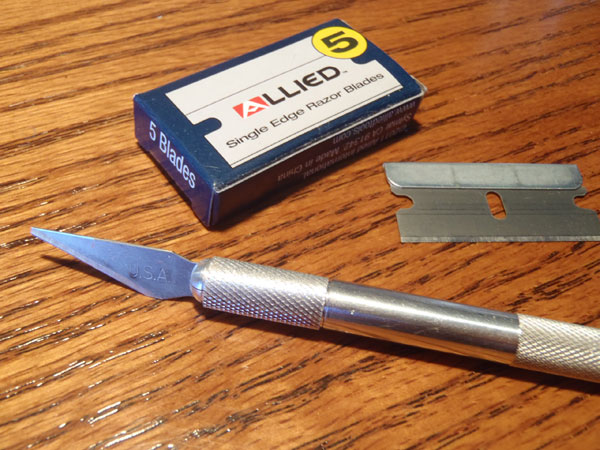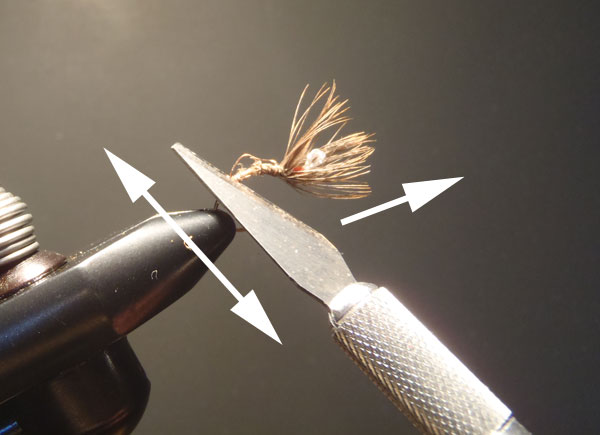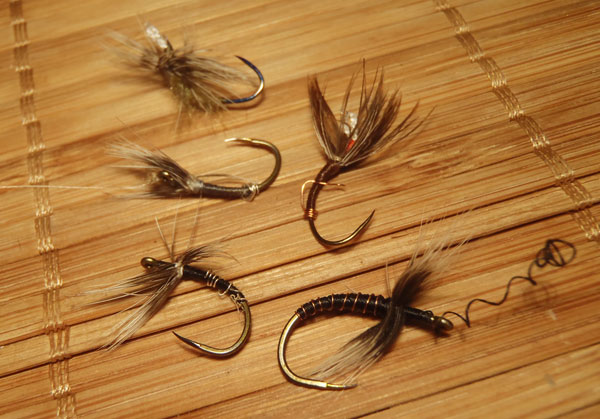Let’s face it. Even the most expertly tied fly is not immortal. Though it might have escaped the perils of underwater snags, tree branches lurking in our backcasts, or weak knots, it will eventually succumb to the merciless jaws of countless trout ripping it to shreds. And at some point, it’s time to retire it. The problem is that hooks today are made so well, that they far outlive the comparatively fragile thread, fur, and feathers we tie our flies with. It’s a shame to throw them away when they’re still perfectly good. It’s even worse when you ties with expensive or hard-to-find hooks. So, why not reuse them?
A brilliantly terrible idea
I had never even considered recycling my hooks until about ten years ago when my oldest fishing buddy George told me a story about his brilliant idea to save money. Over the years, he had acquired a pile of flies that were basically trashed but the hooks were still good. And when I say “pile”, I mean a probably hundreds and hundreds of flies. He was trying to come up with a good way to remove all the material from the hooks so he could reuse them. But there were too many to do one by one (it would have taken days). He wanted to find a solution that would take care of them all at once. Finally, George came up with his Eureka moment. He poured all the flies into a jumbo sized coffee can, doused it with gasoline, and lit it up. It worked perfectly! All the material was burnt off, right down to the bare hook shank. It seemed like the perfect solution, until he started tying with them…
He put one of the hooks into his vise and started the thread. Almost immediately, it snapped in half. He tried another. The same thing happened. This went on a few more times until George figured out that the heat from the flames had removed the temper from the steel. It made them brittle, and essentially useless. So instead of saving a couple of hundred dollars, he was left with a pile of ruined hooks, and a good story to tell others while getting rigged up at the tailgate.
A Better way to recycle fly hooks
Since then, I have never been able to find a way to strip materials off of hooks en masse. Of course, I tend to not accumulate vast quantities of trashed flies like George. I typically lose them before they unravel. Many anglers say that they more trashed their flies get, the buggier they look and the more they catch fish. I think this is true, but only to a certain point. And every season, I end up with a handful of flies that are beyond believable to trout anymore, yet their hooks are still in good condition. And in my experience, the best way to reuse them is to strip off the material one by one.
All you need is a razor blade and a little patience. A straight razor will work, but I prefer X-acto-style knives or razors with a handle since it gives you better leverage. And of course, the sharper, the better.

You’ve probably already guessed the technique: Take the razor, and shave off the materials from the hook shank. That’s easy enough but here are a few caveats you might not have thought of:
- Rather than merely pushing the razor along the hook shank, move it back and forth in a “sawing” motion as you go. This will cut through tougher materials like thread more easily.
- Start at the bend of the hook, not the eye. The reason for this is that the hook will flex less closer to where it is gripped in the vise jaws. If you start at the eye, the hook will flex more making it more difficult to cut the materials. Plus, if you start at the eye, you have a much better chance of stabbing your hand with the hook point (trust me on that one).
- If possible, try not to scrape the anodized coating off of the hook. If you do this and expose the raw steel, the hook will probably rust. And the last thing you want connecting you and that 20-incher is a rusty hook!
- Wire ribbing is tough to cut through. Hopefully, your fly is so beat up that it’s already unraveled. But if not, try to cut the thread enough so that you can unwind the wire before shaving the rest of the fly.

Is it really worth it?
Now you might think that it would be a waste of time to sit there at your desk scraping off materials just to save a lousy hook or two when you could be tying instead. And normally, I’d agree with you. But I tie on some hooks from Japan that only seem to be sporadically available on eBay. I never know when the next batch will be available so it makes sense for me to not use up my reserves if I don’t have to. I probably don’t save much money by doing it–it’s really more so I don’t run out during a drought. However, I’m sure for some, it actually will be a money save (especially if you have a penchant for expensive or exotic hooks). It’s really up to you to decide if it’s worth it or not.
If you do decide to recycle your hooks, here’s another tip so that it doesn’t turn into a time sink. Instead of sitting down with a big pile of flies for a long “shaving session”, I keep my trashed flies at my tying desk. When I sit down to tie a fly, I first look in the pile to see if there’s one with the hook that I want to use. Then, I strip it down and tie with that hook. It only takes a few seconds and saves time by not having to find all the right packages to put them back into my hook inventory.
Do you reuse your hooks? Does it save you money?









I rarely reuse hooks because, like you I lose them before they become unrecognizable. The only time I reuse them is if it’s an expensive or hard to find hook. But I only tie a select few flies on those $8 packs of umpquas.
I’ve never thought about recycling hooks. But now that you bring up the idea, another idea springs to mind from my background in geology. That idea would employ the use of a rock tumbler. Now such a machine is meant to highly polish rocks, so I am not sure what setting or grit would be used to de-feather/de-thread a fly while only perhaps lightly polishing a hook. What may be useful is that wire wrapped hooks may retain the wire wrap perhaps thus eliminating a step in making wire-weighted nymphs.
Now the price of a tumbler is not going to allow a person to do this on his own (unless one already polishes agates, etc.), so it might be a cooperative effort that occurs among fly-fishers in an area. It might be possible that a fly shop could provide such a service and in doing so be one way to draw people into their shop for further business.
So, I wonder if the idea might have some efficacy. Doesn’t sound like a money-maker, more for good-will. I wonder too how one might separate hooks from the grit – a sieve? Oh well….
These fellows like your idea:
http://www.flytyingforum.com/index.php?showtopic=61181#
And these think it is not worth it:
http://www.laflyfish.com/cgi-bin/bforum/viewtopic.php?id=2089
This guy uses pliers:
http://www.youtube.com/watch?v=Zl8nrxXQ_PE
…
I have recycled hooks for quite a while especially big streamer hooks for steelhead. In fact i bet there is a pack of razors in my tying kit. I’m intrigued by the rock tumbler idea. I don’t know if it would work but I can think of two ways to get the hooks out. One would be like you said Lynn, a sieve, but one other idea that may work a bit better would be a magnet.
I do exactly the samething Jason when recycling flies, once you get the hang of it, its quite easy. I usually touch up the hook point with a fine emery board while its held in the vise or a pair of forceps too.
What hooks are they? I might be able to get them for you and save you the trouble.
Hi Chris, for example, these Gosen Torrents-Ace hooks with the black finish in 7 or 7.5: https://www.tenkaratalk.com/2012/05/gosen-torrents-ace-eyeless-tenkara-hooks/
something to do towards the end of winter, when you go cabin crazy waiting for season start. the hooks would need to be worth the effort for the time.
i’m curious if a watered down bleach solution would weaken organic materials on the beat up fly and allow one to remove the materials in a batch while leaving the integrity of the hook intact?
Sorry, it’s just not worth it! I would rather tie than un-tie. I think Most Tenkara fishermen can buy 25 or 100 hooks. I personally loose far less flies while Tenkara fishing.
I’ve recycled hundreds of conventional flies for years. Basically via the straight razor method as posted or with a lighter. Though the flame method probably weakens the hook, it’s never shown as a problem.
I never thought of recycling like that although I have cut off a badly tied fly and retied it. I’ll probably start doing this some because I have taken to using a lot of Dohiku barbless hooks from the Czech Republic and, although not expensive, it is a bit if time/trouble getting them.
Good article
Check out this easy way to recycle your fly hooks:
https://www.youtube.com/watch?v=Zl8nrxXQ_PE
Cheers,
Michael